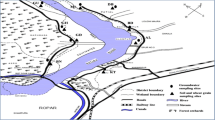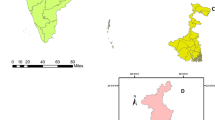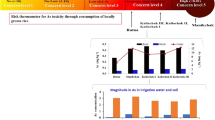Abstract
In the present study, potential health risks posed to human population from Ropar wetland and its vicinity, by consumption of inorganic arsenic (i-As) via arsenic contaminated rice grains and groundwater, were assessed. Total arsenic (t-As) in soil and rice grains were found in the range of 0.06–0.11 mg/kg and 0.03–0.33 mg/kg, respectively, on dry weight basis. Total arsenic in groundwater was in the range of 2.31–15.91 μg/L. i-As was calculated from t-As using relevant conversion factors. Rice plants were found to be arsenic accumulators as bioconcentration factor (BCF) was observed to be >1 in 75% of rice grain samples. Further, correlation analysis revealed that arsenic accumulation in rice grains decreased with increase in the electrical conductivity of soil. One-way ANOVA, cluster analysis and principal component analysis indicated that both geogenic and anthropogenic sources affected t-As in soil and groundwater. Hazard index and total cancer risk estimated for individuals from the study area were above the USEPA limits of 1.00 and 1.00 × 10−6, respectively. Kruskal-Wallis H test indicated that groundwater intake posed significantly higher health risk than rice grain consumption (χ 2(1) = 17.280, p = 0.00003).



Similar content being viewed by others
References
Abedin MJ, Cresser MS, Meharg AA, Feldmann J, Howells JC (2002) Arsenic accumulation and metabolism in rice (Oryza sativa L.) Environ Sci Technol 36:962–968
Aggarwal SK (2009) Heavy metal pollution. A. P. H. Publishing Corporation, New Delhi
Agilent Technologies (2012) Agilent Vapor Generation Accessory VGA 77 User’s guide manual part number 8510104700, 10th edn. Agilent Technologies, Inc, Santa Clara
Allen SE, Grimshaw HM, Rowland AP (1986) Chemical analysis. In: Moore PD, Chapman SB (eds) Methods in plant ecology. Blackwell Scientific Publications, London, pp 285–344
APHA (American Public Health Association) (2005) Standard methods for the examination of water and wastewater, 21st edn. American Public Health Association, American Water Works Association and Water Environment Federation, Washington, DC
Arain MB, Kazi TG, Baig JA, Jamali MK, Afridi HI, Shah AQ, Jalbani N, Sarfraz RA (2009) Determination of arsenic levels in lake water, sediment and food stuff from selected area of Sindh, Pakistan: estimation of daily dietary intake. Food Chem Toxicol 47:242–248
Baker AJM (1981) Accumulators and excluders—strategies in the response of plants to heavy metals. J Plant Nutr 3(1–4):643–654
BIS (Bureau of Indian Standards) (2012) Indian standard drinking water-specifications (second revision of IS 10500). Bureau of Indian Standards, New Delhi
Bortey-Sam N, Nakayama SM, Ikenaka Y, Akoto O, Baidoo E, Mizukawa H, Ishizuka M (2015) Health risk assessment of heavy metals and metalloid in drinking water from communities near gold mines in Tarkawa, Ghana. Environ Monit Assess 187(397):1–12
Brammer H, Ravenscroft P (2009) Arsenic in groundwater: a threat to sustainable agriculture in South and South East Asia. Environ Int 35:647–654
Brouwer C, Goffeau A, Heibloem M (1985) Irrigation water management: training manual no. 1—introduction to irrigation. Food and Agriculture Organization of the United Nations, Rome
Bundschuh J, Nath B, Bhattacharya P, Lin CW, Armienta MA, Lopez MVM, Lopez DL, Jean JS, Cornejo L, Macedo LFL, Filho AT (2012) Arsenic in the human food chain: the Latin American perspective. Sci Total Environ 429:92–106
Chakraborti D, Mukherjee SC, Pati S, Sengupta MK, Rahman MM, Chowdhury UK, Lodh D, Chanda CR, Chakraborti AK, Basu GK (2003) Arsenic groundwater contamination in middle Ganga Plain, Bihar, India: a future danger? Environ Health Perspect 111:1194–1201
Choi B, Choi S, Kim D, Huang M, Kim N, Park K, Kim C, Lee H, Yum Y, Han E, Kang T, Yu I, Park J (2010) Effects of repeated seafood consumption on urinary excretion of arsenic species by volunteers. Arch Environ Contam Toxicol 58(1):222–229
EFSA (European Food Safety Authority) (2014) Dietary exposure to inorganic arsenic in the European population. EFSA J 12(3):3597
Ehi-Eromosele CO, Adaramodu AA, Anake WU, Ajanaku CU, Edobor-Osoh A (2012) Comparison of three methods of digestion for trace metal analysis in surface dust collected from an Ewaste recycling site. Nat Sci 10:42–47
ESOPB (Economic and Statistical Organisation Government of Punjab) (2006–2007) Household consumer expenditure in Punjab, NSS 63rd round (July 2006–June 2007), Economic and Statistical Organisation Government of Punjab, Chandigarh. http://www.esopb.gov.in/static/PDF/Publications/National-Sample-Survey/Report-HouseHold-Consumer-Expenditure-NSS-63rd-Round.pdf/ Accessed 2 Dec 2016
Guha Mazumder DN (2003) Chronic arsenic toxicity: clinical features, epidemiology, and treatment: experience in West Bengal. J Environ Sci Health A 38(1):141–163
Huang M, Zhou S, Sun B, Zhao Q (2008) Heavy metals in wheat grain: assessment of potential health risk for inhabitants in Kunshan, China. Sci Total Environ 45:54–61
Jan FA, Ishaq M, Khan S, Ihsanullah I, Ahmad I, Shakirullah M (2010) A comparative study of human health risks via consumption of food crops grown on wastewater irrigated soil (Peshawar) and relatively clean water irrigated soil (lower Dir). J Hazard Mater 179:612–621
JECFA (Joint FAO/ WHO Expert Committee on Food Additives) (2014) Joint FAO/ WHO food standards programme of the Codex Alimentarius Commission. Report of the sixth session of the Codex Committee on contaminants in foods (REP12/CF). Food and Agriculture Organization/ World Health Organization, Rome ftp://ftp.fao.org/codex/reports/reports_2012/REP12_CFe.pdf . Accessed 11 Oct 2016
Kaur M, Soodan RK, Katnoria JK, Bhardwaj R, Pakade YB, Nagpal AK (2014) Analysis of physico-chemical parameters, genotoxicity and oxidative stress inducing potential of soils of some agricultural fields under rice cultivation. TropPlant Res 1(3):49–61
Khabaz-Saberi H, Rengel Z (2010) Aluminum, manganese, and iron tolerance improves performance of wheat genotypes in waterlogged acidic soils. J Plant Nutr Soil Sci 172:461–468
Leblebici Z, Aksoy A, Duman F (2011) Influence of salinity on the growth and heavy metal accumulation capacity of Spirodela polyrrhiza (Lemnaceae). Turk J Biol 35:215–220
Meharg AA, Jardine L (2003) Arsenic transport into paddy rice (Oryza sativa) roots. New Phytol 157:39–44
Patil VT, Patil PR (2010) Physicochemical analysis of selected groundwater samples of Amalner Town in Jalgaon District, Maharashtra, India. E-J Chem 7(1):111–116
Rahman MA, Hasegawa H, Rahman MM, Rahman MA, Miah MAM (2007) Accumulation of arsenic in tissues of rice plant (Oryza sativa L.) and its distribution in fractions of rice grain. Chemosphere 69:942–948
Rahman MM, Owens G, Naidu R (2009) Arsenic levels in rice grain and assessment of daily dietary intake from rice in arsenic-contaminated regions of Bangladesh—implications to groundwater irrigation. Environ Geochem Health 31:179–187
Ramanathan AL, Johnston S, Mukherjee A, Nath B (2015) Safe and sustainable use of arsenic contaminated aquifers in the Gangetic Plain: a multidisciplinary approach. Spinger International Publishing, Cham
Rengel Z (2015) Availability of Mn, Zn and Fe in the rhizosphere. J Soil Sci Plant Nutr 15(2):397–409
Roychowdhury T (2008) Impact of sedimentary arsenic through irrigated groundwater on soil, plant, crops and continuum from Bengal Delta: special reference to raw and cooked rice. Food Chem Toxicol 46:2856–2864
Roychowdhury T, Uchino T, Tokunaga H, Ando M (2002) Survey of arsenic in food composites from an arsenic-affected area of West Bengal, India. Food Chem Toxicol 40:1611–1621
Sharma S, Kaur J, Nagpal AK, Kaur I (2016a) Quantitative assessment of possible human health risk associated with consumption of arsenic contaminated groundwater and wheat grains from Ropar wetland and its environs. Environ Monit Assess 188:506
Sharma DA, Rishi MS, Keesari T (2016b) Evaluation of groundwater quality and suitability for irrigation and drinking purposes in southwest Punjab, India using hydrochemical approach. Appl Water Sci. doi:10.1007/s13201-016-0456-6
Sigrist M, Hilbe N, Brusa L, Campagonoli D, Beldoménico H (2016) Total arsenic in selected food samples from Argentina: estimation of their contribution to inorganic arsenic dietary intake. Food Chem 210:96–101
Smith E, Naidu R, Alston AM (2002) Chemistry of inorganic arsenic in soils: II. Effect of phosphorus, sodium, and calcium on arsenic sorption. J Environ Qual 31:557–563
Su YH, McGrath SP, Zhao FJ (2010) Rice is more efficient in arsenite uptake and translocation than wheat and barley. Plant Soil 328:27–34
SWRCB (State Water Resources Control Board) (2006) Domestic water quality and monitoring regulations. In: SWRCB, California Code of Regulation Title 22 Division 4. Environmental Health. State Water Resources Control Board, California, pp 1–12
Tiwana NS, Jairath N, Saxena SK, Sharma V (2008) Conservation of RAMSAR sites in Punjab. In: Sengupta M, Dalwani R, (ed) Proceedings of Taal 2007: The 12th World Lake Conference. Ministry of Environment and Forests, Government of India, Jaipur, pp 1463–1469
Trivedi RK, Goel PK, Trisal CL (1987) Practical methods in ecology and environmental sciences. Enviro Media Publications, Karad
USEPA (United States Environmental Protection Agency) (1989) Risk assessment guidance for superfund volume 1 human health evaluation manual (part a) interim final EPA/540/l -89/002 (Vol. I). United States Environmental Protection Agency, Washington, DC
USEPA (United States Environmental Protection Agency) (2015) Risk based screening table-generic, summary table. (2015). http://www.epa.gov/risk/risk-based-screening-table-generic-tables/ Accessed 31 Jan 2016
WHO (World Health Organization) (2006) Guidelines for drinking-water quality, vol 1, 3rd edn. WHO Press, Geneva
Xu XY, McGrath SP, Meharg AA, Zhao FJ (2008) Growing rice aerobically markedly decreases arsenic accumulation. Environ Sci Technol 42:5574–5579
Zhao FZ, McGrath SP, Meharg AA (2010) Arsenic as a food chain contaminant: mechanisms of plant uptake and metabolism and mitigation strategies. Annu Rev Plant Biol 61:35–59
Acknowledgements
The authors are grateful to University Grants Commission (UGC), New Delhi, India, for providing the financial assistance for this study under the University with Potential for Excellence (UPE) scheme (under the holistic area of Environmental Management), Departmental Research Support-Special Assistance Programme (DRS-SAP) and Centre with Potential for Excellence in Particular Area (CPEPA) scheme. The authors would also like to thank Dr. Jatinder Kaur Katnoria (Asst. Professor, Department of Botanical and Environmental Sciences, Guru Nanak Dev University, Amritsar, Punjab, India) for her guidance and support throughout the study, especially during As, Mn and Fe estimation.
Author information
Authors and Affiliations
Corresponding author
Ethics declarations
Conflict of interest
The authors declare that there is no conflict of interest.
Additional information
Responsible editor: Philippe Garrigues
Rights and permissions
About this article
Cite this article
Sharma, S., Kaur, I. & Nagpal, A.K. Assessment of arsenic content in soil, rice grains and groundwater and associated health risks in human population from Ropar wetland, India, and its vicinity. Environ Sci Pollut Res 24, 18836–18848 (2017). https://doi.org/10.1007/s11356-017-9401-y
Received:
Accepted:
Published:
Issue Date:
DOI: https://doi.org/10.1007/s11356-017-9401-y




